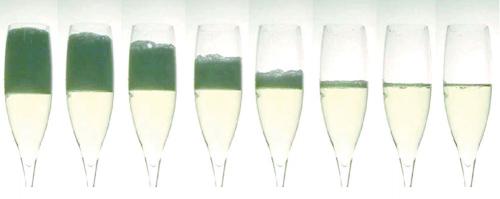The appearance of foam when a sparkling wine is poured into a glass is regarded as an important sensory perception feature, especially for marketing. Further, the formation and duration of a ring of bubbles around the glass/liquid surface interface, or the mousse, together with the size or diameter of the bubbles are also perceived quality factors from a consumer’s point of view.
Over the years that I taught sparkling wine production to oenology students, I was constantly intrigued as to what wine components drive the foam behaviour. It seemed that it had to be a yeast output resulting from the secondary fermentation. This idea was reinforced by the apparent relationship between ageing on lees post-secondary fermentation and foam behaviour; that is, the longer the time on lees, the better the foam quality seemed to be. These observations obviously exclude consideration of carbonated wines, that is those made by injecting carbon dioxide into a wine post primary fermentation.
I was fortunate to meet Professor Andrea Curioni of the University of Padova at a wine conference where he outlined the measurements that had been performed on Prosecco at his university. After developing a standard pouring technique, foam behaviour was recorded by video camera. The image, kindly provided by Andrea, shows one result. The foam decreases smoothly with a consequent small increase in liquid height. Six Prosecco wines were examined by pouring the sample into the glass up to a specified height (one can see the marker on the left side of the glass), with each pouring replicated six times. Five of the six wines had maximum foam height above the liquid surface between 6 and 8 centimetres while one only made it to 1.7 centimetres. Foam decay times for four wines ranged from 5 to 8 seconds, with one (the low foam height) taking only 1.7 seconds, while one with an initial good foam height was still decaying after about 20 seconds.
These original experiments have not been published. I was fortunate to get access to all the images for use in my teaching program and the students loved the challenge of making their own foam assessment. In follow-up work, the Padova group published in 2014 (Food Hydrocoll. vol. 34, pp. 202–7) the results of ‘reconstitution’ experiments where five macromolecular fractions were isolated from a Prosecco wine and added back to the wine before ageing on lees. One fraction containing yeast mannoproteins showed the best foam behaviour, while grape-derived proline-rich proteins had no impact. An apparent cooperative effect between the two fractions gave a better ‘foamability’ than the individual fractions.
Many studies have attempted to define the critical chemical compounds that influence sparkling wine foam. These have been recently reviewed in Critical Reviews in Food Science and Nutrition (2019, vol. 59, pp. 2072–94). Drawing conclusions is, as the review authors point out, difficult due to differences in foam assessment techniques and production methods (bottle fermentation, tank fermentation or carbonation) as well as the time of ageing on lees. Many of the studies are focused on the style of wine common to the region where the research was performed (e.g. Champagne, Prosecco, Cava) and this also makes drawing broad conclusions a challenge.
In an attempt to address some of the present limitation in our knowledge, Bruna Condé in her doctoral program at the University of Melbourne used synchronous fluorescence spectroscopy to examine the ‘chemical interactions influencing foam characteristics’ (Beverages 2019, vol. 5, paper 54). Using a rather fancy robotic pourer with computer vision (Food Control 2017, vol. 71, pp. 383–92) to measure foam behaviour, fluorescence spectra were recorded for several sparkling wines after a range of wine compounds were added. Interpretation of the spectra showed that mannoproteins were linked to foam stability whereas phenolic compounds had a tendency to increase the number of smaller bubbles. The possibility of a polyphenolic compound–protein interaction influencing foam behaviour was also proposed. The authors recognised that their results may reflect the response of the additions made to the wine.
While reconstitution experiments have their place, there is a clear need for metabolic profiling of actual unadjusted wines, coupled with an agreed procedure for assessing foam behaviour and then relating the fluorescence spectra to foam behaviour. Extensive data analysis using advanced chemometrics techniques should allow the identification of critical wine components.



